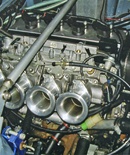All Nonfiction
- Bullying
- Books
- Academic
- Author Interviews
- Celebrity interviews
- College Articles
- College Essays
- Educator of the Year
- Heroes
- Interviews
- Memoir
- Personal Experience
- Sports
- Travel & Culture
All Opinions
- Bullying
- Current Events / Politics
- Discrimination
- Drugs / Alcohol / Smoking
- Entertainment / Celebrities
- Environment
- Love / Relationships
- Movies / Music / TV
- Pop Culture / Trends
- School / College
- Social Issues / Civics
- Spirituality / Religion
- Sports / Hobbies
All Hot Topics
- Bullying
- Community Service
- Environment
- Health
- Letters to the Editor
- Pride & Prejudice
- What Matters
- Back
Summer Guide
- Program Links
- Program Reviews
- Back
College Guide
- College Links
- College Reviews
- College Essays
- College Articles
- Back
Transformers
Magnetism is where an object has the ability to attract and repel, even without touching, other objects. These objects are usually made of iron, steel, nickel, cobalt, aluminum, and magnetite. Magnets are energized by a magnetic field. A magnetic field is made out of moving charges and a current from the charges. The electrons of the atoms that make up a magnet are in constant motion. When opposite ends of magnets interact, the field lines on the magnets connect with one of the north poles and one of the south poles. North and south poles attract one another. When two south or two north poles interact, the magnets repel.
Direct current (dc) is an electric current where the flow of charge or electrons is always in one direction. A battery produces direct current because the terminals always have the same sign. The charges or electrons are moving from the negative terminal to the positive terminal, which causes the current to always move in the same direction. Alternating currents (ac) is an electric current that frequently changes direction. Alternating currents usually appear in a generator by switching the sign at the terminals. Most currents that alternate directions move at a frequency of 60 cycles per second, which is a 60-hertz current. Most residential circuits have an alternating current.
An electromagnet can be made by the alignment of magnetic domains in a piece of iron placed in a current carrying wire. If the iron produces a strong magnet it is an electromagnet. The strength can be increased in the electromagnet by increasing the current going through the coil. The electromagnet becomes strengthened or permanent which creates a magnetic field when the electromagnet is connected to a direct current. When the electromagnet is connected to an alternating current, the electromagnet loses energy in the magnetic core.
Changing magnetic fields produce electric fields, as changing electric fields produce magnetic fields. An electric generator converts mechanical energy into electrical energy. The voltage induced by the generator is an alternating current. The more coils you put into the generator would create more energy for the generator to induce. This correlates with Faraday’s Law because Faraday’s Law states that the induced voltage in a coil is proportional to the number of loops, multiplied by the rate at which the magnetic field changes within those loops.
A transformer is a device that increases or decreases voltage or transfers electric power through two coils by electromagnetic induction. Transformers consist of two coils or wires, a primary wire and a secondary wire. The primary wire is the input wire and the secondary wire is the output. Transformers are necessary to use for houses or residential places because the voltage that is being transferred outside is too high for use in a house.
Transformers have alternating currents. Transformers do not use direct currents because in a direct current, there is no change in the current, leading to no change in the magnetic field. A changing magnetic field must be present to induce an electric current. When the primary wire in the transformer changes, changes in the magnetic field occur. These changes extend to the secondary wire, leading to voltage being induced in the secondary wire. If the number of turns of wire is the same in both coils, voltage input and output is the same. If the secondary has more turns, greater voltage will be induced in the secondary. This is an example of a step-up transformer. If the secondary has less turns than the primary, a step-down transformer would occur. The primary wire is powered by an alternating current and the secondary wire is connected to an external circuit.

Similar Articles
JOIN THE DISCUSSION
This article has 0 comments.
